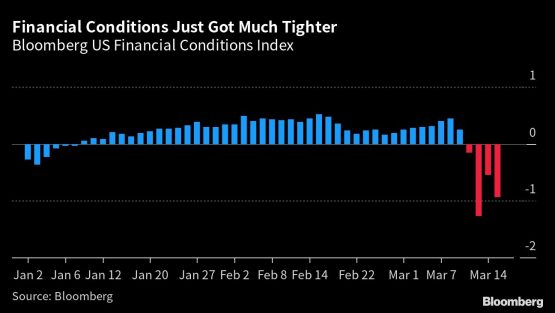The key to if — or when — the US economy falls into recession will depend on how the latest turmoil in the banking sector spills over to Main Street.
Less lending and tighter loan standards would make it tougher for people to buy cars and homes, and harder for businesses to expand and invest. Elevated concerns about the banking system and heightened odds of a recession also risk turning households more cautious about spending and businesses wary of beefing up payrolls or pursuing capital investments.
The economy was already showing some cracks from the Federal Reserve’s steep interest-rate hikes to stave off inflation. The failure of three US banks followed by a crisis of confidence in Credit Suisse Group AG spooked investors on concerns about the stability of the financial sector.
With conditions changing by the hour, traditional economic data points — typically released monthly or quarterly with a lag — prove less helpful.
Following are some places to look to gauge the economic fallout from the tumult in the banking sector. It should be noted, though, that some of these indicators have already retreated in recent months which will make deciphering the impact even more challenging:
Bank lending
Each Friday around 4:15 p.m. in Washington the Fed releases a slew of information on assets and liabilities at the nation’s commercial banks. Statistics on consumer, real estate and commercial loans are all included, as well as broken out into broader categories based on bank size.
The report, known as the H.8, will be closely watched by economists and investors for insight into lending patterns and deposits at both regional banks and the nation’s biggest banks.
The Senior Loan Officer Opinion Survey on Bank Lending Practices is a quarterly survey of up to 80 large domestic banks and 24 US branches of foreign banks that also offers insight into lending standards as well as demand for and loans to businesses and households.
While not a high-frequency measure, the next report will be released in April — an opportune insight in the wake of the turbulence seen in March. Indications of a tightening of bank lending standards may raise concerns about the economy’s prospects.
Consumer confidence
Consumer confidence is fickle and fragile, and while certainly not perfect, it can at times help signal changes in personal spending.
Early indications are that the upheaval in the banking sector is having an impact. A measure by Penta and CivicScience showed confidence in the US economy fell by the most since June in the two weeks ended March 14.
Results of the University of Michigan’s March survey of consumers, set for release later on Friday, was conducted Feb. 22-March 15 and will likely reflect some impact from the latest market turmoil. The final index, out March 31, will offer a clearer picture of consumers’ initial reaction to the bank failures. The data are released twice a month.
The Conference Board has a similar measure, which is due on March 28.
Credit card spending
A key way to assess whether Americans are pulling back on spending is through credit card data.
The Bureau of Economic Analysis estimates spending on a variety of services and merchandise using daily payment card data. Unlike personal spending data that’s released monthly and with a significant lag, BEA generally updates this data weekly.
Several private sources also regularly provide insights into consumer spending patterns, including Bank of America Corp. and Visa Inc.
Business Sentiment
The Census Bureau’s Business Trends and Outlook Survey offers one way to get timely insight into firms across the economy. The survey is sent out to roughly 200,000 businesses every two weeks and includes figures on performance, revenue, employees and hours worked. The next release will include the two weeks ending March 26.
The National Federation of Independent Business, a small-business association, regularly polls its members on questions like hiring plans, capital expenditures, and ease of getting a loan. The NFIB released their latest results earlier this week, so the next reading won’t come for about another month. Reports come out on the second Tuesday of each month.
Household behavior
The Household Pulse Survey, an experimental Census Bureau survey started in the depths of the pandemic, has become a key source of timely information on topics ranging from employment status to food sufficiency and methods used to meet spending needs. The data are collected in two-week intervals of two-weeks on, two-weeks off.
OpenTable, a booking platform for reservations at restaurants, has daily data on reservations at the national level as well as across a variety of US cities. While it can be volatile, a sustained downturn in reservations could point to Americans pulling back on discretionary spending.
Job availability
Businesses tend to slow and ultimately freeze hiring when demand wanes in order to limit job cuts. While government data on vacancies is published with a significant lag, many job-search websites offer much more up-to-date figures on the status of labor demand.
Indeed offers a near real-time look at job postings on their site by country, state, city and sector. Vacancies in many sectors were already on the decline before the events of the last week.
Reductions in temporary staffing can also be an indicator of business concerns about the future. The final step is larger layoffs, something that can often be seen in WARN notices — or an advance notice of plant closings and mass layoffs — before government metrics.
© 2023 Bloomberg

